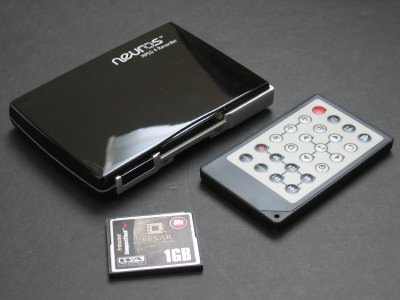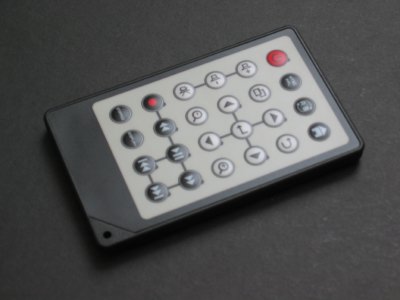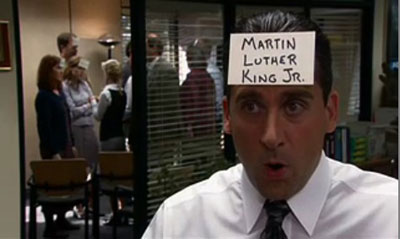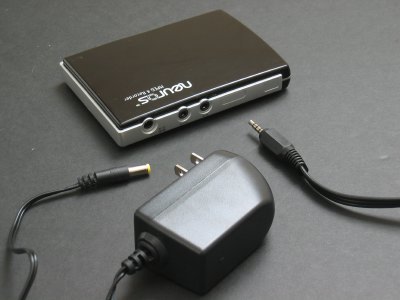Neuros MPEG-4 Recorder 2 -Mp4Converter.net
Updated March 18,2006
Pros: A very cheap standalone video recorder that instantly creates iPod-compatible 320x240 video files from an attached video device. Includes scheduled recording functionality, a 24-button Infrared remote control, video cables and a power supply.
Cons: Users have to provide a flash card by themselves for recordings as well as a device to transfer the cards’ contents to their computers and iTunes. Videos quality aren't so satisfactory, especially when watch through computer. Recording requires video device to be turned on to the correct channel; no TV tuner is included. High-resolution (640x480) videos require conversion to iPod-ready format.
Video recording has developed for a long time since the VCR - now that there’s TiVo (and many competing PC and Mac capture solutions), would you want to go back to a VCR-like solution? If yes, or you’re operating on a limited budget, the Neuros MPEG-4 Recorder 2 ($150) could be a good choice to your iPod video recording needs. Those looking for superior quality recording and more sophisticated menuing functionality will have to pay for it, but they may also find the extra expense to be worthwhile.

Neuros’s small glossy black and silver box is connected to any video source with composite (RCA-style) output plugs, and then to your television set via another set of composite plugs. A power supply and both of these cables are included in the box. If you’re recording from a TV with a single tuner and set of outputs, this means that you’ll plug the MPEG-4 Recorder 2 into the same device twice, once for input, and once for output - a bit tricky if you want a live preview of what you’re recording. As there are no buttons on the MPEG-4 Recorder 2 itself, an included, adequate 24-button Infrared remote control provides all of your access to the video device’s recording features, as well as a number of other features that iPod owners won’t use. The remote will bring up an on-screen menu system that’s highly reminiscent of the ones on VCRs - not smooth and TiVo-like, but functional - to manually set recording timers - multiple ones, if you want - with automatic follow-ups on the schedule you prefer.

On a positive note, the MPEG-4 Recorder 2 works. Set up a 320x240 recording, make sure your TV or other video device is turned on (!) and playing back, and the video device will churn out an iPod-ready MPEG-4 video file that will also play in iTunes. You can choose between various levels of quality, and also higher resolutions - up to 640x480 - if you prefer. The 640x480 video files won’t play on the iPod, but they will play back and convert to iPod video with iTunes; we successfully tested both playback and conversion with iTunes. On the iPod’s screen, the 320x240 video files look very similar to the ones Apple’s selling, enough in fact that most people won’t care about the differences, other than the logos and other interruptions (read: commercials) networks add to the broadcast videos.


That’s not to say that the video files are identical. They’re not. The first picture above is a still image from a Neuros-recorded video of the TV show The Office, the one below from an iTunes Music Store video. Neuros’s videos were obviously grainier and less vibrant in color than videos purchased through the iTunes Music Store, and while the graininess could be mitigated by using higher quality recording standards and then converting the videos, the color couldn’t be. Conversion is a process we really prefer not to go through if we can avoid it - it adds inconvenience and additional time (roughly 45 minutes, give or take, for a 30 minute video) to the process. Additionally, Neuros 320- and 640-pixel files preserve the black bars (letterboxing) you’ll see on non-widescreen TVs when viewing widescreen-formatted TV shows, while Apple’s files do not. (A 368x208 widescreen recording mode is available, but not automatic.) This will matter more if Apple releases a widescreen-ready iPod, which may not deal as well with non-widescreen format videos.
There’s another VCR-like element to the MPEG-4 Recorder 2, and one that will complicate the transfer-to-iPod process quite a bit for some people: you must own and insert either a CompactFlash card or a Memory Stick Pro card in order to save your recordings. The MPEG-4 Recorder 2 has no internal storage capability, or cabled method to transfer files directly from the recorder to your computer. This means that you’ll need to have a memory card of some sort with a hundred or hundreds of Megabytes of free space if you’re planning to record television in 30-minute chunks. Our TV shows consumed around 100 MB per 30 minutes in 320x240 mode, and over 200 MB per 30 minutes in 640x480 mode, so a 512MB card will likely do for iPod recording of a single 320x240 movie or four short TV shows at once, or a 1GB card for higher quality or more recording time. Since many people already have CompactFlash cards, this isn’t awful, but if you don’t, you’ll need the memory (approx. $40/512MB) and a card reader (approx. $30).

If you already have CompactFlash or Memory Stick Pro media and a card reader, the MPEG-4 Recorder 2 provides one of the lower-cost iPod-ready recording options we’ve seen. If not, you’ll spend roughly as much on all of those components as you would on a computer-integrated recording system like EyeTV 2 plus its hardware, which will boast greater recording versatility and quality, without requiring you to turn on your TV every time you want to record video - howevere, a time-consuming conversion of every recording will be required. Both approaches have their pros and cons, though, so you’ll have to decide which alternative better meets your personal needs.
Mac Software
Hot Suite
- More for Less Promotion
- DVD to iPod Suite for Mac
- Mac DVD Toolkit
- iPhone Software Suite for Mac
- Media Toolkit Ultimate for Mac
MP4 Software
iPad/iPhone/iPod Software
- iPad Max Platinum for Mac
- DVD to iPad Converter for Mac
- iPad to Mac Transfer
- iPad Max for Mac
- iPad Video Converter for Mac
- iPhone Max Platinum for Mac
- iPhone Max for Mac
- iPhone Apps Transfer for Mac
- iPhone Ringtone Maker for Mac
- iPhone Video Converter for Mac
- iPhone to Mac Transfer
- iPod Max Platinum for Mac
- iPod Max for Mac
- iPod Video Converter for Mac
- DVD to iPod Converter for Mac
- iPod to Mac Transfer
Video Converter
- Video Converter for Mac
- Movie Editor for Mac
- HD Video Converter for Mac
- Apple TV Video Converter for Mac
- Online Video Converter for Mac
- Video Editor for Mac
- HEVC-H.265 Converter for Mac
DVD/CD/Blu Ray Software
Windows Software
Hot Suite
iPad/iPhone/iPod Software
- iPad Max Platinum
- iPad Max
- iPad Video Converter
- iPad to PC Transfer
- iPhone Apps Transfer
- Blu-ray to iPad Converter
- YouTube to iPad Converter
- iPhone Max Platinum
- iPhone Ringtone Maker
- iPhone Video Converter
- iPhone Transfer
- iPhone Contacts Transfer
- iPod Max Platinum
- iPod to PC Transfer
- iPod Video Converter
Video Converter
- Video Cutter 2
- Video Converter
- Online Video Converter
- HD Video Converter
- 3GP Video Converter
- MP4 to MP3 Converter
- MP3 Converter
- MP4 Converter
- PS3 Video Converter
- DPG Converter
- HEVC/H.265 Converter
DVD/CD/Blu Ray Software
PPT/PDF Software
Articles
- How to download YouTube videos for free
- How to download/convert YouTube videos to iPod
- How to download and convert YouTube videos
- All features of apple iPhone
- Now you can get more TV offerings from Apple iTunes
- Video Streamer HAVA from Snappy Multimedia
- iPod Growth Driving Demand for Flash Memory
- MediaMan HVX-3500 Review
- Uncertain whether new iPod will be delayed or not because of hurdles
- T3's top five iPod alternatives
- Envivio Exhibits MPEG-4 Solutions from Mobile to HD at CCBN2006
